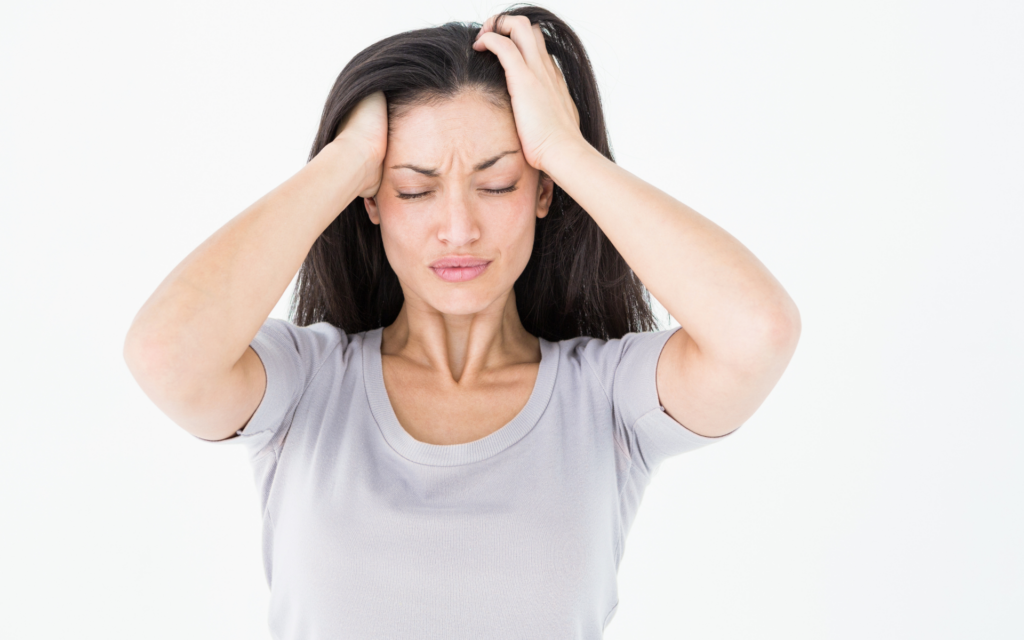One common challenge faced by individuals experiencing period migraines is the disruption these headaches cause to their daily routines and overall quality of life. Period migraines, which predominantly affect women, are closely intertwined with the hormonal fluctuations that occur during the menstrual cycle.
Characterised by intense headaches accompanied by various symptoms, such as nausea, sensitivity to light and sound, and fatigue, these migraines can significantly impair one’s ability to function normally.
Understanding the unique nature of period migraines, identifying their triggers, and implementing effective management strategies are essential for those grappling with this condition. This comprehensive guide looks into the root causes, hallmark symptoms, and diverse treatment options for period migraines, offering valuable insights and practical advice aimed at empowering individuals to anticipate, cope with, and alleviate the burden of these cyclical headaches.
What is a Period Migraine?
Period migraines, a specific type of migraine headache, coincide with the menstrual cycle, affecting many women. These debilitating headaches typically arise just before or during menstruation, when estrogen levels drop significantly. Unlike regular migraines, period migraines have a clear and predictable pattern linked to hormonal fluctuations.
What Do They Differ from Regular Migraines?
The main features that set period migraines apart from regular migraines are their timing and triggers. Period migraines are closely related to hormonal fluctuations during the menstrual cycle, whereas regular migraines can be triggered by stress, certain foods, or insufficient sleep. Period migraineurs are usually women who follow a pattern, especially around the time of their menstruation. Due to their cyclical nature, managing these migraines remains equally challenging, even though this predictability may provide some degree of foresight.
How Common Are Period Migraines and What Impact Do They Have?
Many women who experience migraines also experience fairly common period migraines. According to research, roughly 60% of women who experience migraines say that their menstrual cycle and their headaches are related. These migraines can have a significant negative impact on daily activities, work, and general quality of life due to their extreme pain and discomfort. Period migraines can worsen due to anticipatory anxiety caused by their predictable nature.
Causes and Triggers
Understanding the causes and triggers of period migraines is essential for effective management and prevention. Period migraines are primarily driven by hormonal changes, but other factors can also play a role. By identifying these triggers, women can better anticipate and mitigate migraine attacks.
How Do Hormonal Fluctuations Cause Period Migraines?
Hormonal fluctuations, particularly the drop in estrogen levels that occurs just before menstruation, are the primary cause of period migraines. Estrogen is believed to play a role in regulating brain function and the sensitivity of pain pathways. When estrogen levels fall, it can trigger a migraine by making the brain more susceptible to other triggers. This hormonal drop is a natural part of the menstrual cycle, making period migraines a regular and often predictable occurrence for many women.
What Are the Common Triggers for Period Migraines?
In addition to hormonal changes, several other factors can trigger period migraines. Common triggers include:
- Stress: Emotional stress can exacerbate migraine symptoms.
- Sleep Disruptions: Irregular sleep patterns or lack of sleep can trigger migraines.
- Diet: Certain foods and beverages, such as caffeine, alcohol, and processed foods, may trigger migraines.
- Environmental Factors: Weather changes, exposure to bright lights, or strong smells can also act as triggers.
- Medications: Some medications, particularly those affecting hormone levels, can influence migraine frequency and severity.
Symptoms and Diagnosis
Recognising the symptoms of period migraines and obtaining an accurate diagnosis are crucial steps toward effective treatment and management. These migraines present unique challenges and often require a tailored approach to distinguish them from other types of headaches.
How Can You Identify Symptoms of Period Migraines?
Identifying symptoms of period migraines involves recognizing a pattern in the timing and nature of the headaches in relation to the menstrual cycle. Typically, these migraines present with severe throbbing pain, often localised to one side of the head. This intense pain can significantly disrupt daily activities and is a hallmark symptom distinguishing migraine from other types of headaches. In addition to the pain, nausea and vomiting are common, which can further debilitate those affected, making it difficult to maintain normal routines. The need for a dark and quiet environment becomes apparent due to heightened sensitivity to light and sound, which are classic migraine symptoms exacerbated during period migraines.
Moreover, some women may experience aura symptoms preceding the onset of a migraine. These auras can manifest as visual disturbances, such as flashing lights, zigzag patterns, or temporary vision loss. Other aura symptoms might include tingling in the limbs or face and difficulties with speech. The timing of these migraines is notably linked to the menstrual cycle, usually occurring just before or during menstruation when estrogen levels drop. Tracking these symptoms and their correlation with the menstrual cycle can help in diagnosing period migraines and distinguishing them from other types of headaches, thus aiding in more effective management and treatment.
How Is a Period Migraine Diagnosed?
Diagnosing period migraines involves a thorough medical history and symptom tracking. Women are often advised to keep a headache diary, noting the timing, frequency, and severity of migraines in relation to their menstrual cycle. A healthcare provider will review this diary, along with any other relevant medical information, to diagnose period migraines. In some cases, additional tests may be performed to rule out other causes of headaches.
Period Migraine Management and Treatment
Effectively managing and treating period migraines involves a comprehensive approach that includes lifestyle adjustments, preventive strategies, and medical treatments. Understanding the available prescription treatments can significantly improve the quality of life for women suffering from these debilitating headaches, providing relief and reducing the frequency and severity of migraine attacks.
What Prescription Treatments Are Available?
Managing period migraines often involves a combination of lifestyle adjustments, over-the-counter medications, and prescription treatments. Prescription treatments are categorized based on their form of administration: oral tablets, injectables, and nasal sprays.
Oral Tablet
Oral tablets are commonly prescribed for the treatment of period migraines. These include triptans, which are effective in relieving migraine symptoms by constricting blood vessels and blocking pain pathways in the brain. Preventive medications, such as beta-blockers or anticonvulsants, may also be prescribed to reduce the frequency of migraines.
Injectable
Injectable treatments, including CGRP (calcitonin gene-related peptide) inhibitors, are a newer option for migraine management. These medications are administered monthly or quarterly and work by blocking the action of CGRP, a protein involved in migraine attacks. Injectable treatments can be particularly beneficial for women with frequent or severe period migraines.
Nasal
Nasal sprays, such as sumatriptan, provide rapid relief from migraine symptoms and are an alternative for those who cannot tolerate oral medications. Nasal sprays deliver medication directly to the bloodstream, offering quick symptom relief, which can be crucial during a migraine attack.
Prevention
Preventing period migraines involves a proactive approach that addresses both lifestyle factors and medical interventions. Lifestyle adjustments play a crucial role in minimizing triggers and promoting overall well-being, complementing medical treatments to provide comprehensive migraine management. Among these lifestyle adjustments, incorporating healthy habits can significantly reduce the frequency and severity of migraines, offering women greater control over their condition.
Lifestyle Adjustments
Making certain lifestyle adjustments can significantly help in preventing period migraines by addressing various triggers and promoting overall well-being. Engaging in regular physical activity is one of the most effective ways to reduce the frequency and severity of migraines, as exercise helps regulate body functions and reduce stress. Maintaining a healthy diet that includes balanced nutrition while avoiding known food triggers, such as processed foods, caffeine, and alcohol, can also play a crucial role in managing symptoms. Stress management techniques, such as meditation, yoga, and deep breathing exercises, are essential for reducing stress levels, which are a common trigger for migraines. Additionally, ensuring regular and quality sleep is vital, as disrupted sleep patterns can lead to increased susceptibility to migraines. By incorporating these lifestyle changes, women can create a more stable environment that mitigates the impact of hormonal fluctuations associated with period migraines.
NSAIDs
Nonsteroidal anti-inflammatory drugs (NSAIDs) can be used as a preventive measure for period migraines. Taking NSAIDs, such as ibuprofen or naproxen, a few days before the onset of menstruation and continuing for a few days into the period can reduce inflammation and prevent the development of migraines.
Hormonal Management
Hormonal management is another strategy to prevent period migraines. This can involve the use of hormonal contraceptives to stabilise estrogen levels and prevent the drop that triggers migraines. Options include:
- Birth Control Pills: These can help regulate hormone levels and reduce the frequency of period migraines.
- Hormonal Patches or Rings: These provide a steady dose of hormones and can be an effective preventive measure.
Conclusion
Period migraines are a challenging condition affecting many women, with symptoms and timing closely tied to the menstrual cycle. Understanding the causes and triggers of period migraines is essential for effective management and treatment. Through a combination of lifestyle adjustments, preventive measures, and appropriate medical treatments, women can find relief from period migraines and improve their quality of life.
Healthcare providers play a crucial role in diagnosing and managing period migraines, offering personalized treatment plans that address the unique needs of each patient. With ongoing research and advancements in migraine treatments, there is hope for more effective and targeted therapies in the future. Women suffering from period migraines should consult with their doctors to explore the best options for their individual circumstances and work towards achieving better migraine control and overall health.







